

Tanning Leather. How to Butcher. There are a few basics you need to know when you are learning to butcher venison, the first of which is: Dont waste anything!
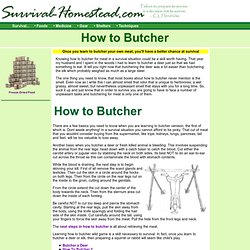
In a survival situation you cannot afford to be picky. That cut of meat that you wouldnt consider buying from the supermarket, like tripe, kidneys, lungs, pancreas, tail and feet, will be too valuable to toss away. Another basic when you butcher a deer or fresh killed animal is bleeding. This involves suspending the animal from the rear legs; head down with a catch basin to catch the blood. Cut either the carotid artery or jugular vein by stabbing the neck on both sides.
While the blood is draining, the next step is to begin skinning your kill. Game Preparation. Small Game Prep & Cookery. Spend a day learning how to convert small game in fur or feather into mouth watering meals.
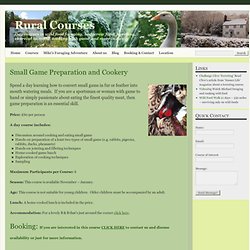
If you are a sportsman or woman with game to hand or simply passionate about eating the finest quality meat, then game preparation is an essential skill. Price: £60 per person A day course includes: Discussion around cooking and eating small gameHands-on preparation of a least two types of small game (e.g. rabbits, pigeons, rabbits, ducks, pheasants)Hands-on jointing and filleting techniquesHome-cooked game lunchExploration of cooking techniquesSampling Maximum Participants per Course: 6 Season: This course is available November – January. Age: This course is not suitable for young children. Lunch: A home cooked lunch is included in the price.
Accommodation: For a lovely B & B that’s just around the corner click here. Knives and Game Preparation. 10 Skills Every Survivalist Should Learn. Free Hunting Tips and Information. How To Skin & Gut An Animal. This post was done by a Forum member Alaska Rose, who is a wealth of knowledge of wilderness and homesteading skills.
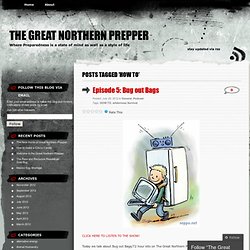
Learn more from her and others on our FORUM This picture shows the most common way to cut the hide for skinning a game animal. The dotted lines around the legs and neck are the usual cuts for removing the head and lower legs. If you do not wish to keep the skin, you may want to just cut any way you can to get it off the animal the quickest way possible. Animal trapping. Animal trapping, or simply trapping, is the use of a device to remotely catch an animal.
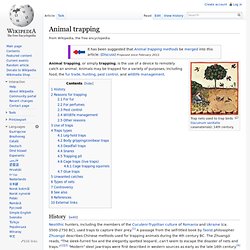
Animals may be trapped for a variety of purposes, including food, the fur trade, hunting, pest control, and wildlife management. History[edit] Neolithic hunters, including the members of the Cucuteni-Trypillian culture of Romania and Ukraine (ca. 5500-2750 BC), used traps to capture their prey.[1] A passage from the self-titled book by Taoist philosopher Zhuangzi describes Chinese methods used for trapping animals during the 4th century BC. The Zhuangzi reads, "The sleek-furred fox and the elegantly spotted leopard...can't seem to escape the disaster of nets and traps.”[2][3] "Modern" steel jaw-traps were first described in western sources as early as the late 16th century.[4] The first mention comes from Leonard Mascall's book on animal trapping.[5] It reads, "a griping trappe made all of yrne, the lowest barre, and the ring or hoope with two clickets. " Reasons for trapping[edit] Hunting Tips.
Animal trapping methods. Although there are a variety of traps used for different purposes, this article focuses on the trapping of fur-bearing animals, and thus relies on foothold traps and conibear traps, though the utility of other types of traps will be discussed.
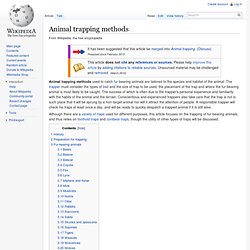
History[edit] In the early 17th century steel leg hold traps were made by blacksmiths. In the early 19th century blacksmiths made animal leg hold traps for Mountain men. Soon after, commercially available factory-made animal traps became available. Trappers traditionally operate alone or with a partner. Preparation for trapping[edit] When preparing new traps, some trappers prefer to allow them be exposed to the elements for several weeks. Hunting strategy. A hunting strategy, or hunting method, is for locating, targeting, and killing a targeted animal.
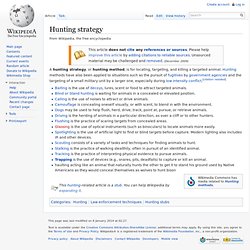
Hunting methods have also been applied to situations such as the pursuit of fugitives by government agencies and the targeting of a small military unit by a larger one, especially during low intensity conflict. [citation needed] Fish preservation. This article is about the act of preserving seafood.
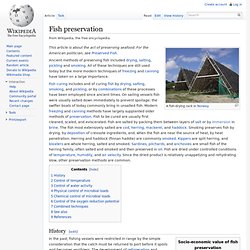
For the American politician, see Preserved Fish. History[edit] Socio-economic value of fish preservation. Hunting. Skillful tracking and acquisition of an elusive target has caused the word hunt to be used in the vernacular as a metaphor, as in treasure hunting, "bargain hunting", and even "hunting down corruption and waste".
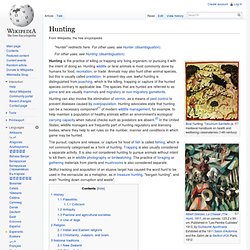
History[edit] Paleolithic[edit] Seafood Network Information Center. The Seafood Network Information Center (SeafoodNIC) was launched in 1997 by Robert J.

Price, Ph.D. and Pamela Tom, M.S. who worked for the seafood technology unit of the University of California Sea Grant Extension Program in cooperation with California Sea Grant College Program; University of California, Davis Department of Food Science and Technology; and the UC Agriculture and Natural Resources. One of the world's first seafood technology network information centers, SeafoodNIC is a portal to Internet resources addressing seafood safety and quality information needs of seafood processors, inspectors, researchers, importers, and food educators. In 1997, the US Food and Drug Administration’s seafood Hazard Analysis and Critical Control Point (HACCP) regulation was implemented.
The scientifically based regulation impacts US processors and importers who are required by law to implement a seafood safety management program to ensure the marketing of safe seafood in the US. Hunting Techniques. Big Game Hunting (Moose, Black Bear and Caribou) Preparation. Guests at Pine Ridge Lodge enjoy the benefits of having their game recovered from the kill site using 8 wheeled ATV’s.
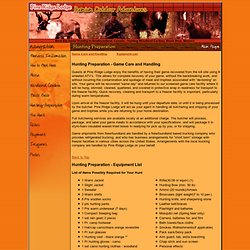
This allows for complete recovery of your game, without the backbreaking work, and without incurring the contamination and spoilage of meat and trophies associated with “de-boning” on site. Your game will be recovered “same day” and returned to our screened game care facility where it will be hung, skinned, cleaned, quartered, and covered in protective wrap in readiness for transport to the freezer facility. Quick recovery, cleaning and transport to a freezer facility is important, particularly during warm temperatures.
Upon arrival at the freezer facility, it will be hung until your departure date, or until it is being processed by the butcher. Pine Ridge Lodge will act as your agent in handling all butchering and shipping of your game and trophies while you are returning to your home destination. Full butchering services are available locally at an additional charge. Information on Indian Tools & Weapons. One of the major American Indian inventions was the tomahawk, which resembles a modern-day hatchet and was used to chop or slice objects. Used by a variety of nations and tribes, this tool could also be used in combat as a close-range weapon or throwing device. Spears were a common design implemented by cultures across the planet.
American Indian spears were generally constructed with a long wooden rod and either a stone or a metal tip. These could be used as weapons in combat or for hunting. The bow and arrow also is believed to have been a relatively common historical tool. Find great kitchen tips at Reader's Digest Australia. Aboriginal Peoples: Hunting Tools and Techniques; Food Preparation and Storage: Newfoundland and Labrador Heritage.
As hunters, fishers and gatherers, the Beothuk moved with the seasons to exploit the most productive migratory animal species on the island, namely seal, salmon, and caribou. In April/May hunting parties pursued harp seal that passed on their migration along the coast; in July, families gathered at river mouths for the harvest of salmon, and during the remainder of the summer dispersed in small groups to fish, collect sea food, hunt sea birds and collect bird eggs. Small Game Prep & Cookery. Game Preparation. Knives and Game Preparation.
Wild Game Preparation Tips. To ensure any meal prepared with wild game will taste it's best the work must start in the field, here are some helpful tips and suggestions to aid you. If you have any further tips please let me know. Survival fishing. Survival fishing techniques to be considered are line, hook, spear, trap and net. Use whatever fishing equipment you can make work. Angling Angling is the most well-known fishing method. You need a hook, line, rod and a small weight to take the hook down. Simple Food Storage Meals for Tight Times: Stock up on three months worth, fast! When a summertime monsoon storm is on the way, I quickly track down my kids, bring them indoors, and prepare to hunker down. It’s a mom-instinct. We unplug the computers, make sure all the windows are securely closed and locked, and if my husband isn’t home, I call to make sure he’s okay. Fishing techniques. Fishing techniques are methods for catching fish.
Game (food) Fishing. Fishing with nets, Mexico Fishing is the activity of trying to catch fish. Fish are normally caught in the wild.